See the evolution of the prom dress from the 1940s to the 2000s
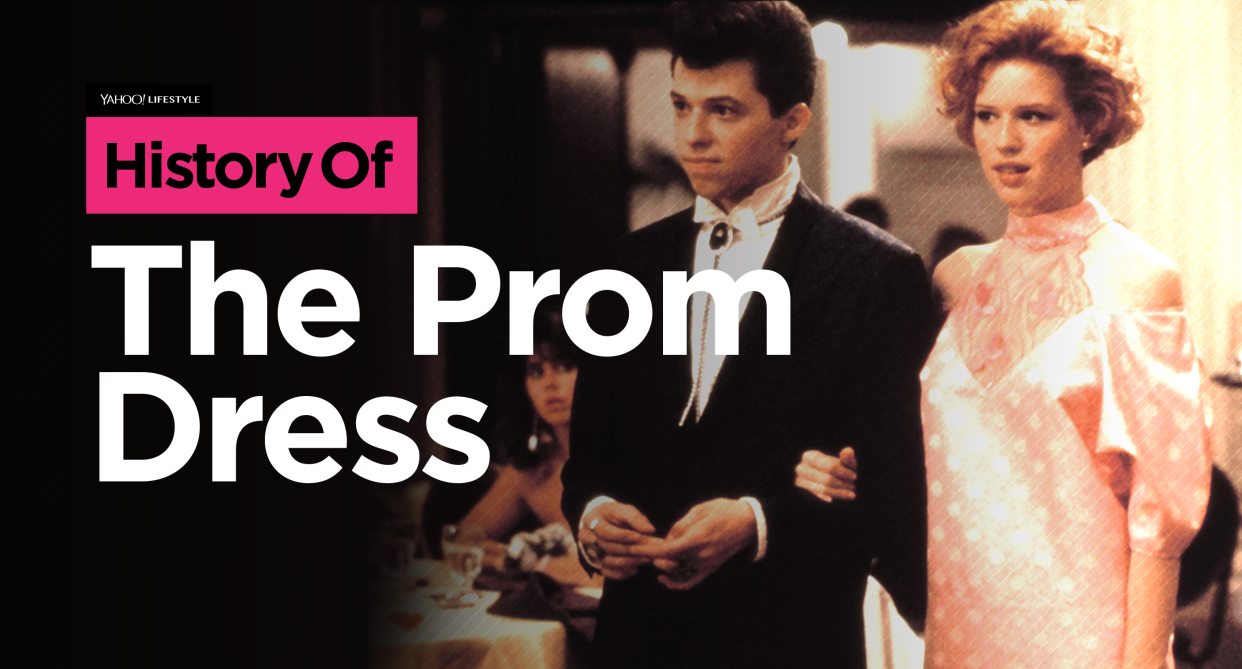
The prom has endured as a meaningful teenhood tradition for decades: It’s a hotly anticipated toast to high school, playing a pivotal part of basically any teen flick worth its salt (not to mention how pivotal it can be IRL too).
But the true roots of prom — short for “promenade” — are as a rite of passage, debuting at Northeast colleges such as Harvard University and Amherst College in the mid- to late 19th century, as relatively simple farewell dances for graduating classes. The practice skewed younger in the decade that followed, emerging as a teen tradition at high schools by the 1940s. Proms are held at some Canadian high schools, and they have also caught on to a lesser extent — and with a younger demographic — in the past decade or so in the U.K., although it hasn’t expanded much farther globally.
Proms are just one type of coming-of-age ceremony, along with quinceañeras, bar/bat mitzvahs, Catholic communions and confirmations, debutante balls, and weddings. All these rites of passage, and the carefully chosen clothes that are worn on these special occasions, have stuck around. But the prom dress differs from most rite-of-passage fashion traditions: It’s nonsecular, and not tied to any particular ethnicity, and, thus, it’s more universal.
It’s also the rare coming-of-age garment that can, and often does, telegraph a teen girl’s burgeoning sexuality, as sociologist Amy Best explores in her 2000 book, Prom Night: Youth, Schools, and Popular Culture. “The prom dress is critically important to this invention of a sexual self,” Best writes, detailing how she overheard some of the girls she interviewed describing their fathers’ “utter discomfort” upon seeing their risqué getups for the big night, which provide proof “that the girls had succeeded in transforming themselves.”

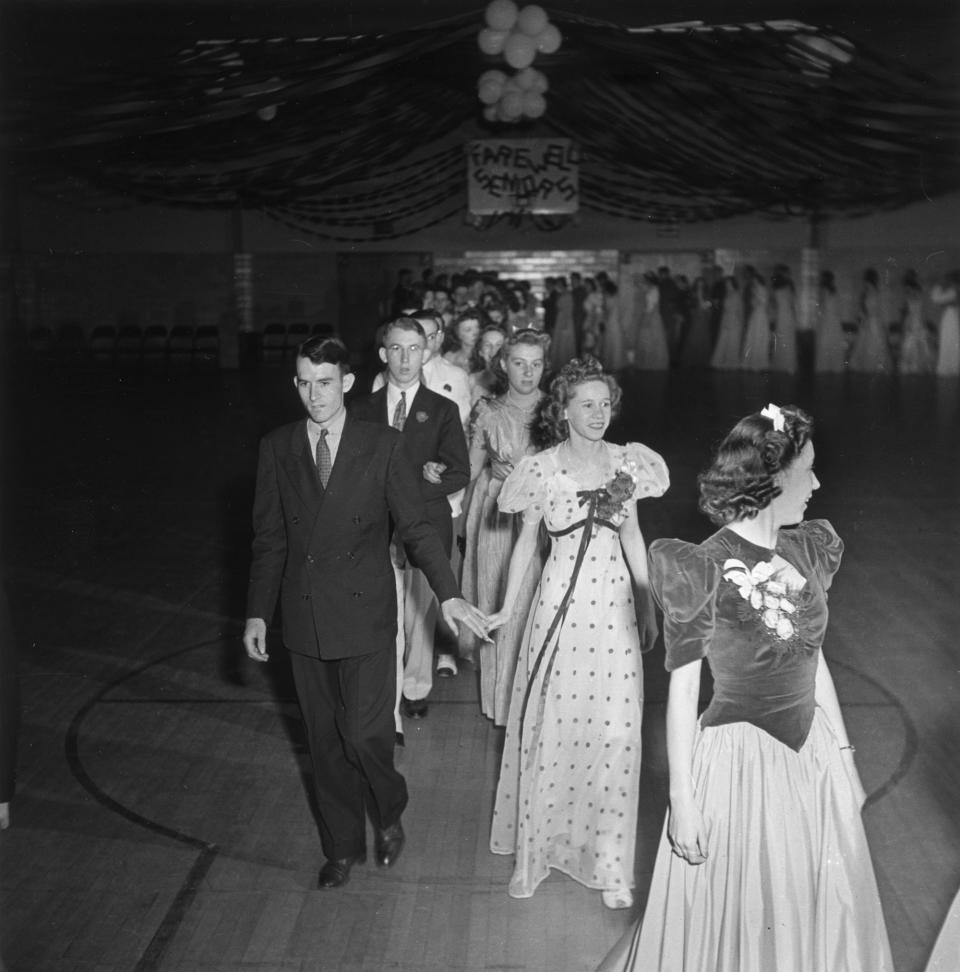
Granted, the prom dress wasn’t very sexy at its midcentury inception. Prim and ultrafeminine was the M.O. instead. In the 1940s, prom dress silhouettes were often cut slim and close to the body. This wasn’t done for the sake of a sexier, more body-con dress: It was due to WWII fabric rations. These frocks had higher necklines and covered shoulders (often with some pouffy volume at the shoulders), with floor-grazing hemlines, often fabricated from heavy materials like velvet and taffeta.


Ultrafeminine, waist-whittling tea-length dresses dominated the fashion vernacular in a big way in the 1950s, and it was the preferred shape for promgoers during that midcentury period too. The style includes fitted waists, full skirts, and calf-grazing hems, falling 3 to 4 inches below the knees. (Interestingly, the term “tea length” actually dates back to the dresses women wore when having teas circa the 1920s.) Some styles even were bedecked with frilly ruffles. Necklines were less demure than in previous decades, for the most part, and strapless styles were also common.

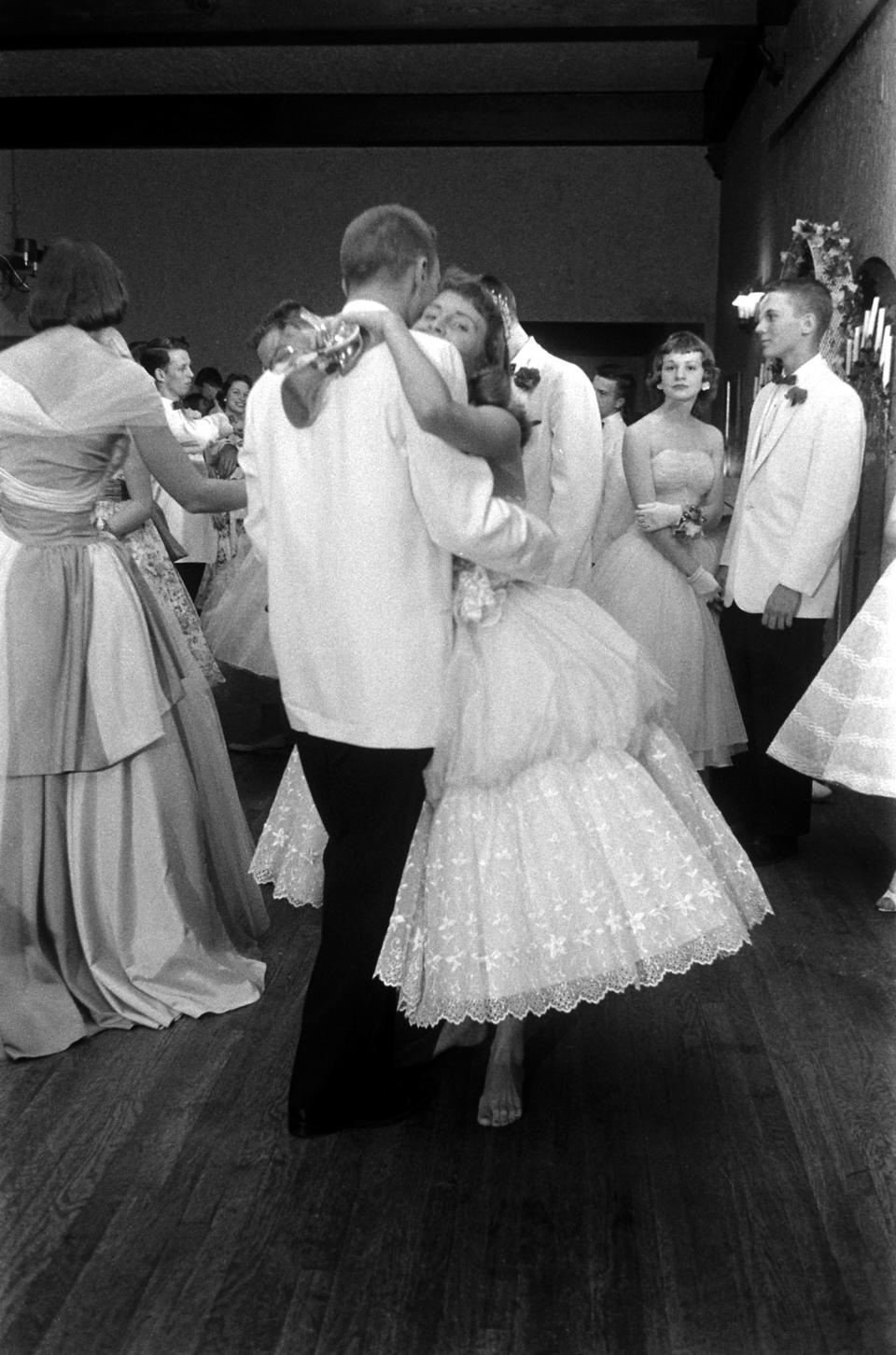
The early ‘60s brought about a return to closer-cut skirting that had been de rigueur two decades earlier, but purely for aesthetic reasons — not as a cost-cutting measure. Slimmer skirts were paired with higher waistlines, making for more of a baby-doll silhouette. Pastel palettes with Easter egg-worthy hues were popular, and dresses moved toward spaghetti-strap and boatneck shapes up top. Later in the decade, empire waist shapes rose to prominence, paired with a range of necklines, like sleeveless boatneck styles and square-neck short-sleeved iterations. And throughout the ‘60s, ultra-voluminous coifs were the norm.
However, proms fell out of favor to an extent as the decade wound down, thanks to shifting cultural attitudes based on political events and attitudes of the time: “The prom’s popularity waned in the late ‘60s and early ‘70s,” Best writes in Prom Night. “With countercultural movements, antiwar protests, and an antiestablishment stance, many ‘irreverent’ youth brought proms to a halt.”

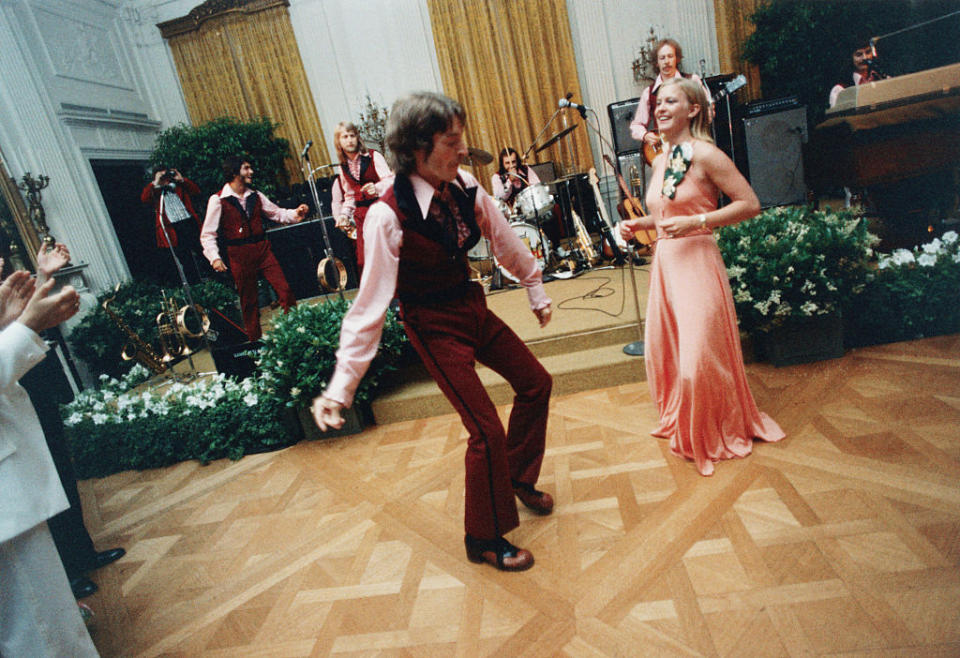
In the 1970s, many prom dresses, reflecting the wider dress trends of the era, became roomier in cut, often without any definition at the waist whatsoever. Unlike the strapless, snug bodices or sleeveless styles that were dominant in previous decades of prom dressing, these frocks tended to have off-the-shoulder, possibly lace-trimmed necklines or long sleeves that were often sheer or billowy.
On the silver screen, Carrie depicted a considerably less dowdy take on the trend: a clean-lined strappy gown with a fluid skirt. Another iconic ‘70s prom dress was worn at the first, and only, prom to be held at the White House: Susan Ford, daughter of President Ford, donned a flowy, salmon-hued jersey gown designed by Albert Capraro, a former assistant to Oscar de la Renta. The frock was trimmed with a few buttons, plus a massive orchid corsage (as her classmates had).

A major prom milestone of the ‘70s was the founding of Jessica McClintock: The brand, created by a former schoolteacher with no formal design training, went on to become synonymous with prom dressing in the ‘80s and ‘90s, and also did big business with bridesmaid gowns and other formalwear during those decades. While the designer herself retired in 2014, and her namesake stores were shuttered around the same time, the label still has licensing deals for some products, such as fragrances.


The maximalism of all things ‘80s certainly didn’t spare the prom dress category. The extravagant excess of the era translated to ultra-pouffy details like oversize bows or ruffles and flashy metallic materials. Tresses were teased and/or crimped, and the makeup of the era tended to be equally as over the top: heavily pigmented lids, copious amounts of self-tanner, and bold lips.
But the most memorable ‘80s prom dresses were certainly in the multiplex, as the teen-movie genre really solidified and took off in the decade, thanks in no small part to John Hughes’s iconic flicks. Take, for example, the pale pink dress — a thrift-store hand-me-down that gets some considerable revamping — worn by Andie (Molly Ringwald) in the seminal 1986 teen classic Pretty in Pink.

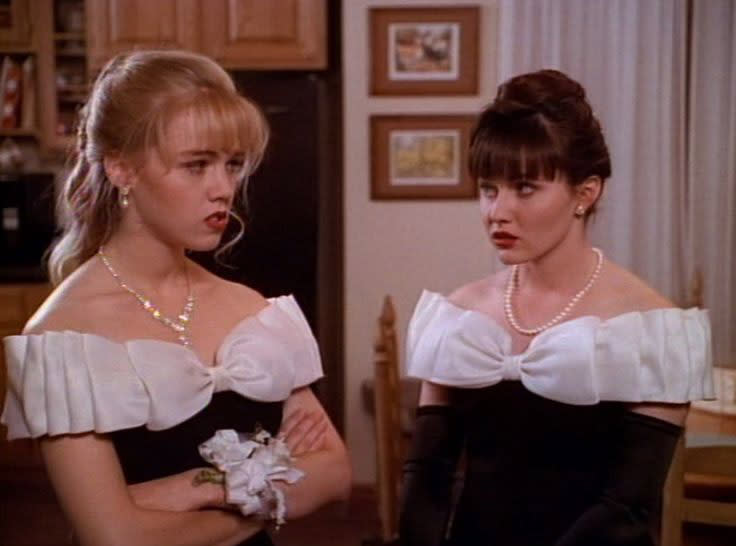
In the early part of the ‘90s, prom frocks looked quite similar to those of the ‘80s in terms of having lots of pouf and ample metallic hues. Sweetheart necklines became quite popular for promgoers (and for fancy occasions in general), and while form-fitting bodices endured, the silhouette shifted slightly, with waistlines hitting closer to the hips.
Shorter hemlines with dramatic necklines were common too, among prom-worthy minidresses of the early ‘90s. To wit: the identical black tube dresses with massive, white bow-adorned off-the-shoulder necklines worn by both Brenda Walsh (Shannen Doherty) and Kelly Taylor (Jennie Garth) on an episode of Beverly Hills 90210 in 1993. The style was so iconic, it inspired a runway look nearly a decade later, when designer Isaac Mizrahi trotted out a similar frock in his resort 2011 collection.

Later in the decade, slinky, spaghetti-strap slip dress or sheath styles reigned supreme. Recalling the iconic and ill-fated style that Sissy Spacek wore (and got drenched in pig blood) in Carrie, two decades before. These styles represented a trickle-down from what was seen on the runway during the era, most memorably in Calvin Klein collections circa the ‘90s. Two epic teen flicks that debuted on the silver screen in 1999 showcased the style: Kat Stratford (Julia Stiles) in a deep purple gown with a lavender shawl in 10 Things I Hate About You, and Laney Boggs (Rachael Leigh Cook) in her post-makeover prom reveal, replete with a sparkly, skinny-strapped LBD.

Other popular silhouettes of the ‘90s included skinny-strapped halter styles, which flaunted ample shoulder and back. As for length, a mix of floor-grazing gowns and minidresses ruled late ‘90s prom dance floors.

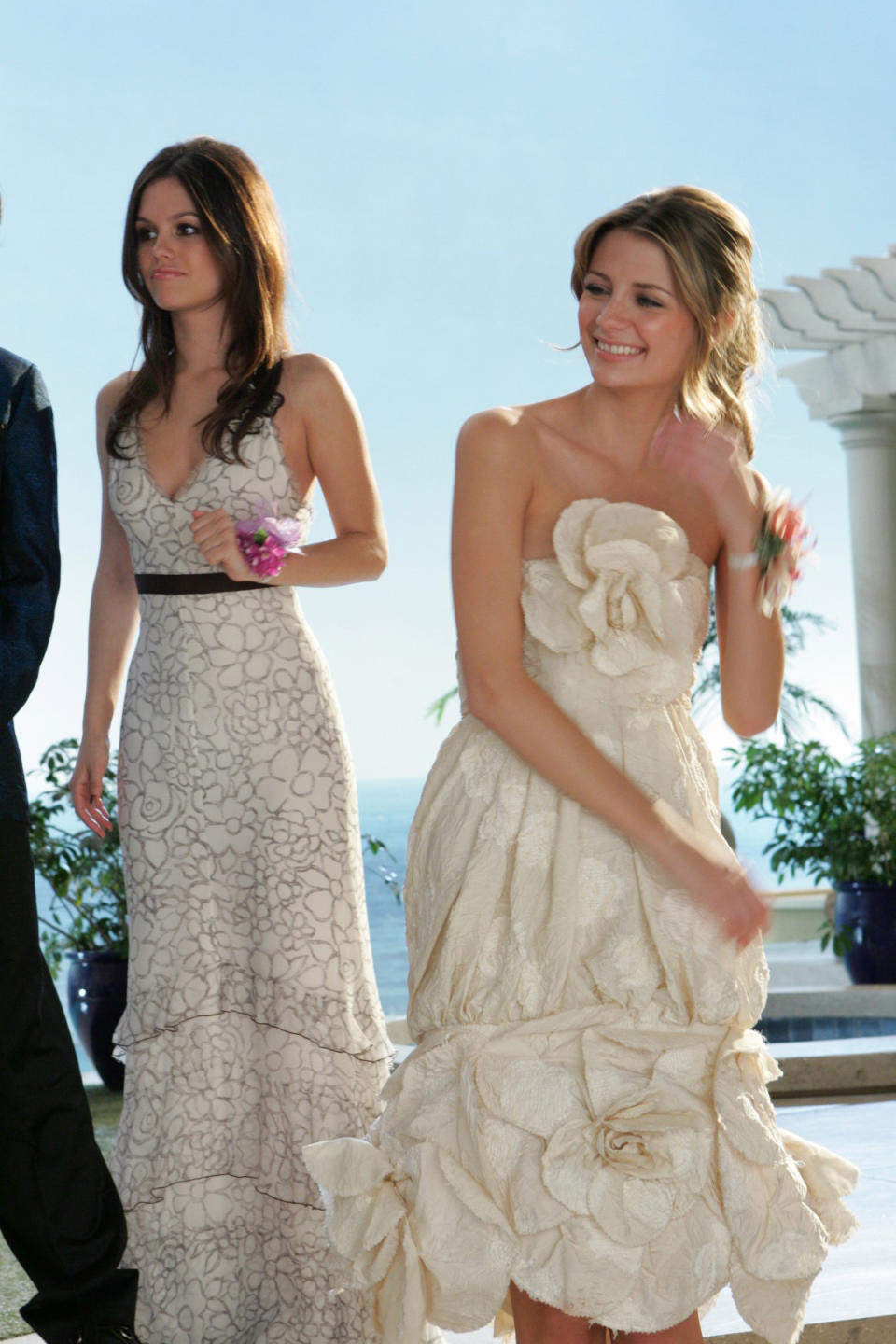
The new millennium brought about a mishmash of prom trends (spurred by the era’s prevailing fashion trends). Think: bubble-hemmed looks, like a wildly unrealistic, straight-off-the-runway Chanel frock worn by Marissa Cooper (Mischa Barton) to the prom on The O.C. in 2006. Strapless gowns with lots of shirred detailing were, and continue to be, popular, often sporting some level of sparkly embellishments and resembling colorful, slightly less voluminous iterations of wedding dresses. Sweetheart necklines, one-shouldered styles, and halter-style necklines were also popular.
Prom dress styles have certainly evolved — and gotten more scintillating — in the past two decades, becoming a more controversial topic in the process. Some schools have enforced restrictive and often sexist dress codes, which tend to predominantly control what girls can and can’t wear to the big event. By the 2010s, risqué prom dresses entered the picture, such as ones sporting dramatic cutouts, which tend to resemble the most revealing of Miss Universe getups or professional dance competition looks.
Social media and the evolution of celebrity red carpet style are largely responsible for these saucier prom looks, which include midriff-flaunting two-piece sets, ultrahigh slits, and sheer overlays on supershort minidresses (the latter lends a sense of modesty to a short, potentially controversial silhouette).
As for prom dresses of the 2020s and beyond, perhaps they’ll stay consistent with the styles dominating dance floors currently. Or the ’20s may usher in an entirely new era of prom frocks, continuing the decades-long tradition of getting gussied up for one last, festive hurrah of the all-important teen years.
Read more from Yahoo Lifestyle:
• This teen wore a Michelle Obama suit jacket to prom to honor the ‘strong black women’ who raised him
• This gay couple is fighting for their right to be their high school’s prom king and king
• This teen is going viral for DIY’ing a $4 thrift-store dress into her ‘dream prom dress’
Follow us on Instagram, Facebook, and Twitter for nonstop inspiration delivered fresh to your feed, every day.


